Mushrooms come in many different colors. Orange mushrooms are not as common as other colors, but they can be found in certain areas.
Some people believe that orange mushrooms have special properties. Others simply enjoy the color and flavor of these mushrooms. Whether you are looking for a unique ingredient for your next dish or want to try something new, orange mushrooms are worth seeking out.
Edible Orange mushrooms Identification
It is important to be cautious when identifying and consuming wild mushrooms, as some species can be poisonous. If you are unsure whether a mushroom is safe to eat, it is best to err on the side of caution and not consume it.
1. Orange Mycena
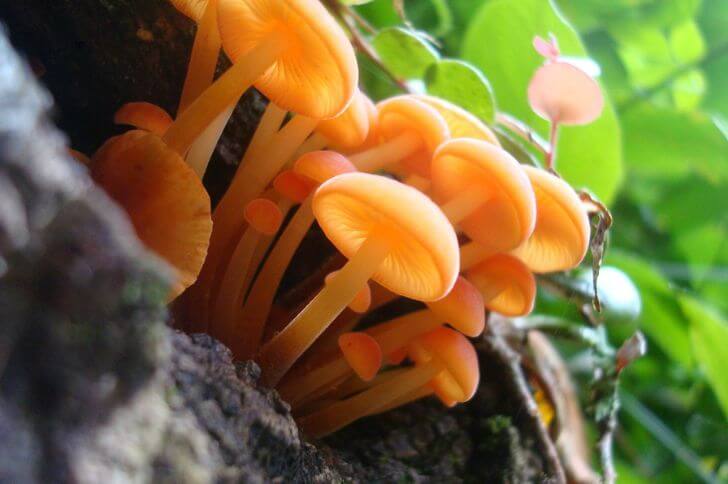
Looking for tiny orange mushrooms that you can eat?You can go wrong with our top choice.
Identification:
Orange mycena is a small, delicate looking mushroom. It’s a vibrant orange in color with a thick stem. The cap measures about 2.8 inches in length. Like other bell shaped mushrooms it has gills under the small cap.
Orange mycena is found in damp, shady areas of woods. It tends to grow on decaying logs or fallen leaves.
Orange mycena are edible mushrooms! But I find them flat tasting and most people have said they don’t have a distinctive taste. But if you want to add color to your meal, consider these bright orange mushrooms.
2. Orange Peel Fungus
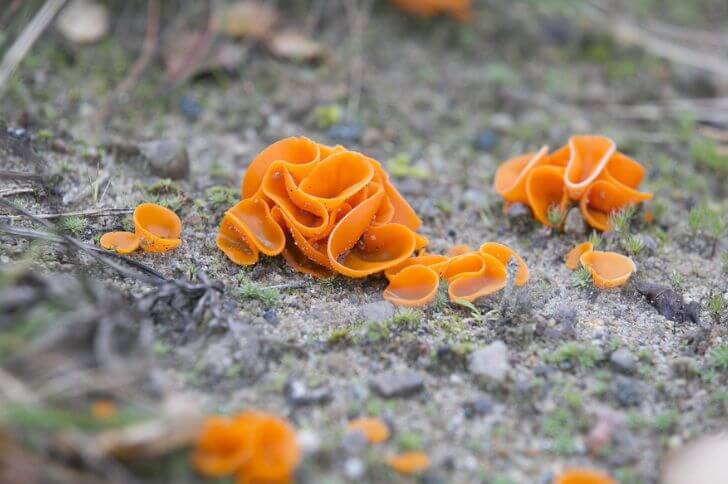
Found in parts of North America, this edible mushroom grows on the ground. Its a member of the pyronemataceae.
Identification:
The cup-shaped bright orange cup grows up to 3.9 inches wide. Its flesh is thin and crumbles easily. The upper surface is covered with white spore print; they are too small to spot with the naked eyes. They do not have a stipe.
When can you see these orange mushrooms? They can be found from August to November. They taste best when fried in butter.
3. Sulphur Shelf Mushroom
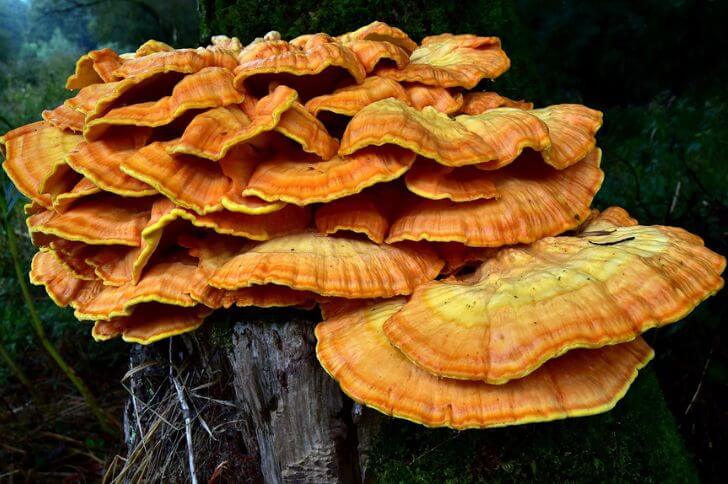
Chicken of the woods, chicken fungus or the Sulphur shelf mushrooms are edible wood mushrooms that are a favorite among foragers.
Identification:
The sulfur shelf mushroom gets its name from its yellow to orange coloration. It grows in dense clusters mostly on oak trees. But you can also check around willows and eucalyptus.
An individual shelf is about 2-10 inches in length. The fruiting body of the sulfur shelf mushroom is flat and has a raised margin. The surface of the fruit body is smooth with small pores that release spores.
Are these orange mushrooms edible? Yes, the chicken of the woods is edible. We recommend you go for young mushrooms. If you are looking for a delicious chicken substitute? You can’ go wrong with this orange yellow mushroom. This mushroom can also be sautéed, grilled, or added to soups and stews.
When can you find them? During spring to early fall.
4. Orange Birch Bolete Mushroom
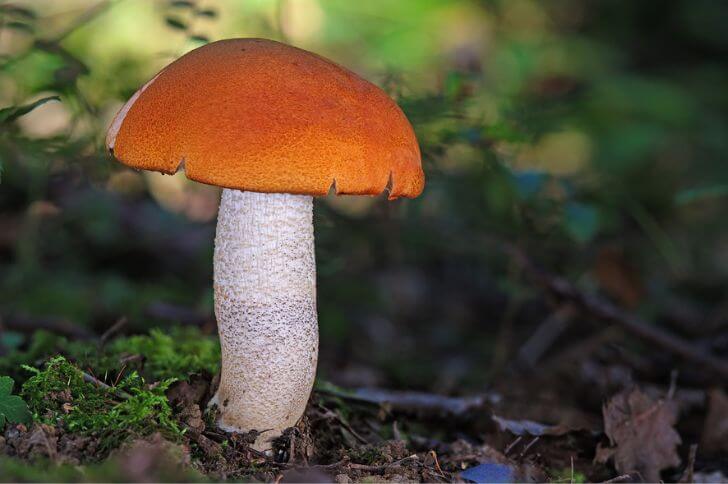
Found in most states, the orange birch bolete mushroom is an edible mushroom that is part of the delicious bolete family.
Identification:
The mushroom has a distinctively orange-red cap, a blue-green stem, and a spongy white flesh. Its orange cap is about 2 inches for young mushrooms and 5-6 inches for fully grown mushrooms.
The orange birch bolete is found in woods with coniferous trees, such as pines and firs. The mushroom typically grows in summer and fall.
The orange birch bolete mushroom is edible, but should be cooked before eating. When cooked, the mushroom has a slightly sweet taste. The spongy white flesh of the mushroom can be used in soups, stews, or sauces.
Related Read: Learn about the Mushrooms in the State of Ohio
5. Gilded Brittlegill
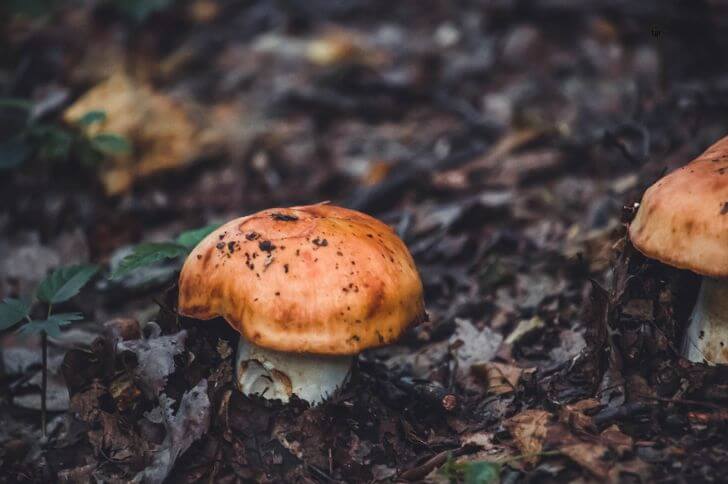
Ever heard of russula mushrooms? If not, here is a quick low down. Russula mushrooms are a species of edible fungi that is found mostly in Europe. It’s common in Summer to the first days of Autumn.
Identification:
This edible mushroom has a distinctively orange cap and yellow gills. The smooth orange cap is 1.5-3.5 inches in diameter while the stipe grows up to 0.98 inches in width and 3 inches tall. Its flesh is white.
This yellow and orange mushroom can be found growing around oak trees. It is a good choice for beginners who are interested in collecting mushrooms for food.
When cooked, the orange brittlegill has a mild flavor. It can be used in soups or sauteed and served as a side dish.
6. Orange Oak Bolete Mushroom
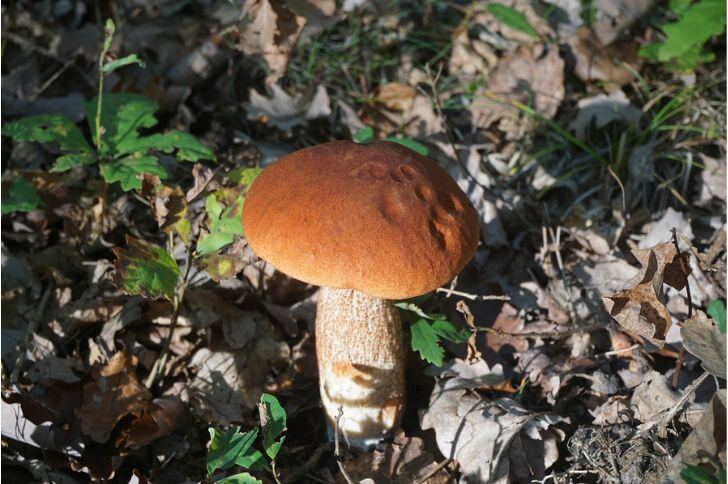
Closely related to the orange birch bolete above, the orange oak bolete or the Leccinum aurantiacum is a common mushroom in Britain.
Identification:
With its orange cap and stout stem, the orange cap bolete mushroom is a striking member of the bolete family. Stem grows up to 6.5 inches while the cap is about 2.6 inches. Notice, the smooth cap is bell shaped.
When you cut it, you’ll notice its thick white flesh which darkens with time. You can forage for this mushroom species from July through November.
Are they edible? Yes, and note that it becomes darker when cooked.
Whether you’re new to mushroom hunting or an experienced mycologist, the orange cap bolete is a must-try fungi. So head to the woods and see if you can find some of these tasty treasures for yourself.
7. Orange Milkcap Mushrooms
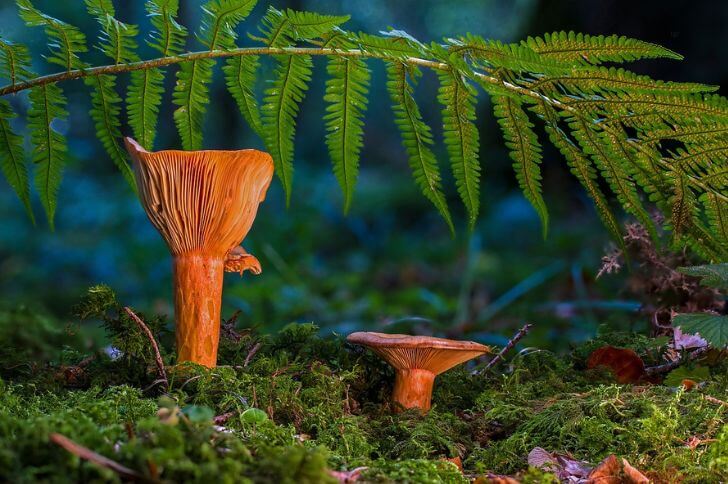
First described in 1801, the orange milkcap mushrooms are another common mushroom of mainland Europe.
Identification:
Orange milkcap mushrooms, also known as Lactarius aurantiacus, are a type of fungi that typically grow in areas with high humidity. These mushrooms are characterized by their orange caps and well-spaced pink gills. When cut or bruised, the orange milkcap mushroom will release a milky white liquid.
Orange milkcap mushrooms are edible, but should be cooked before consumption. These mushrooms can be used in a variety of dishes, such as stews and sauces. When cooking with orange milkcap mushrooms, it is important to remember that they will lose their color when exposed to heat.
8. Orange Oyster Mushrooms
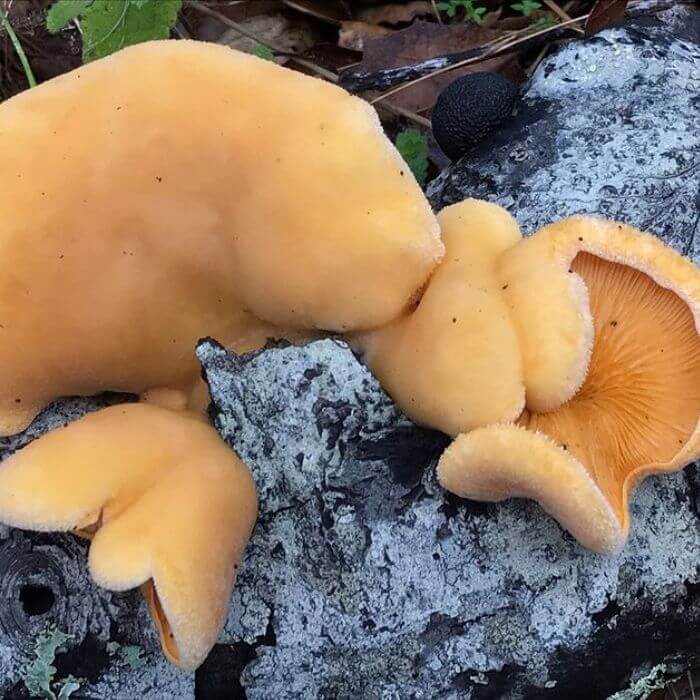
source: jo_qatana
Also known as the mock oyster, the orange oyster mushrooms are found in the Northern Hemisphere from Costa Rica to the North in Alaska.
Identification:
How can you identify them? Orange oyster mushrooms are a type of gilled mushroom that gets its name from its color and shape. The fruit bodies of these mushrooms can be found growing on trees, stumps, and logs. You can find them growing in dense clusters or growing singly on dead trees.
On average the cap grows to 3.9 inches wide. You’ll also notice the crowded thin gills.
Can you eat these oyster mushrooms? Yes, orange oyster mushrooms are classified as edible but they have a very distinctive sulfur smell that puts off a lot of people. It smells like a rotting egg and no one I know wants that for a meal.
9. Golden Trumpet
Often found in wet conifer forests, golden trumpet mushrooms or bell omphalina are bell-shaped mushrooms of North America.
Identification:
Preferring moist environments, this orange fungi has very distinctive features. They have a unique umbrella-like shape and the cap measures 1.9 inches across and stands at 2 inches.
Young mushrooms have the distinctive umbrella shape and as they grow the cap extends upwards, giving it a trumpet shape.
Are they edible? Yes, some people eat golden trumpets. But they have a slightly bitter taste. We recommend you add them to your sauces or soups.
If you’re lucky enough to find some orange mushrooms while out hiking or foraging, you can cook them up and enjoy their unique flavor.
10. Curry Milkcap
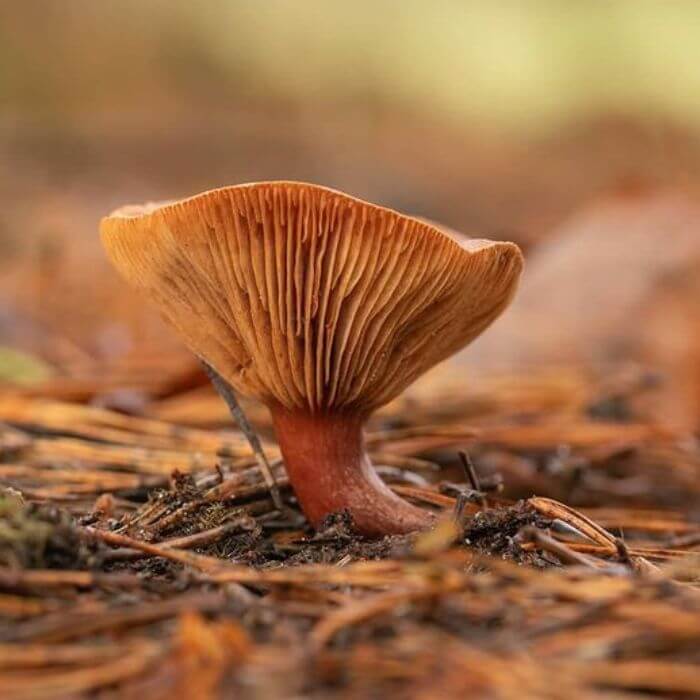
source: sarahw_macro
Why is it called a curry milkcap? Because of the curry smell and milk-like appearance when torn or cut.
Identification:
Curry milkcaps are divided into three groups; lactarius camphoratus which has a curry odor, L.fragilis and L.rubidus are known for their maple odor.
The lactarius camphoratus has a yellow and orange cap that measures about 2-3 inches in diameter.
They are edible and a great truffle substitute. Dry them, grind and store them in powder form.
Inedible Mushrooms that are Orange
11. Jack O’lantern Mushroom
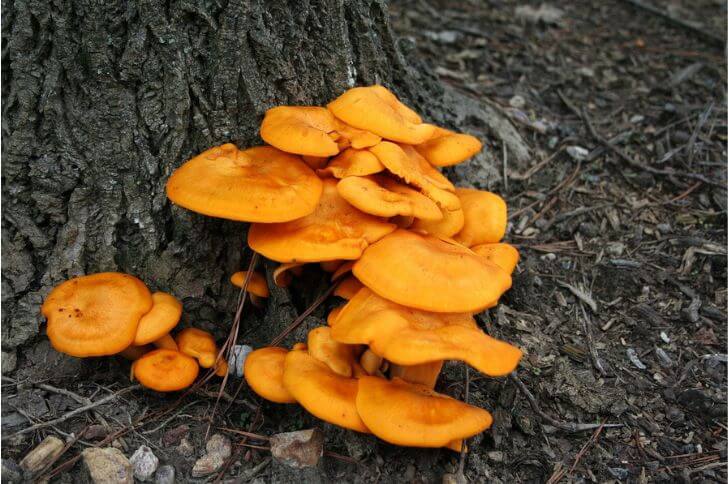
Mushrooms are a fascinating and diverse group of organisms. One of the most well-known mushrooms is the jack o’lantern mushroom ( scientific name – Omphalotus olearius).
Identification:
This mushroom gets its name from its orange color and its resemblance to chanterelles. The orange cap can measure up to 7.8 inches and stand at about 7 inches.
The cap is smooth and underneath you’ll notice its gills. These orange gilled mushrooms grow around hardwood trees or rotting stumps. Unlike chanterelles, these mushrooms grow in tight clusters; this will help you identify them easily.
12. Orange Webcap Mushrooms
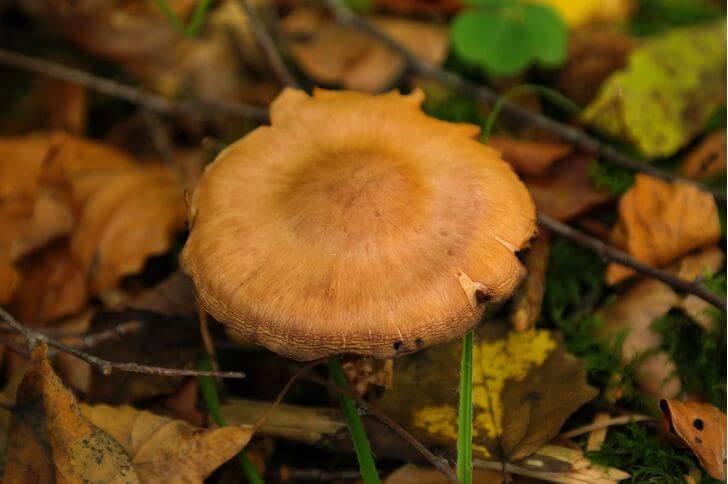
Orange webcap mushrooms are a type of fungi that can be found in North America. They get their name from the orange color of their caps, which can range in size from two to four inches wide.
Identification:
The gills on the underside of the cap are pale yellowish and they release spores that are used for reproduction. Stipe is 2-6 inches in length.
These mushrooms can be found growing on decaying logs or in damp areas of woods. They are often found near conifer trees, as they prefer acidic soil. Orange webcaps are not edible.
13. Orange Fly Agaric Mushrooms
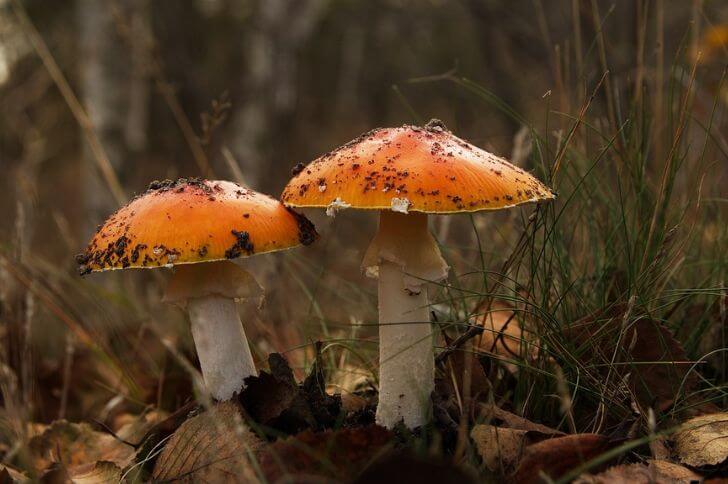
Orange fly agaric mushrooms are a type of fungi that typically grows in damp, shady areas. The fly agaric is the most well-known species of Amanita,
Identification:
They are easily recognized by their bright orange cap with white spots. The cup-shaped cap is covered with white spores. Stipe and flesh is white. Can you eat fly agaric mushrooms? They are non-edible.
14. Sweet Tooth (Hydnum repandum)
Hydnum repandum, sweet tooth or hedgehog mushroom, is a truly distinctive member of the fungi kingdom.
Its striking orange-brown color and unique tooth-like spines underneath the cap set it apart from other mushrooms in the wild.
What makes Hydnum repandum particularly fascinating is its versatility in culinary applications. With a delicate, nutty flavor and firm texture, it adds a delicious dimension to dishes ranging from risottos to pasta sauces.
15. Marasmius siccus
Marasmius siccus, also known as the orange pinwheel mushroom, is a captivating sight to behold in the forest.
Its orange color stands out against the backdrop of green foliage, making it a photographer’s delight. What makes this species truly fascinating is its unique ability to survive desiccation, or extreme dryness.
During periods of drought, Marasmius siccus can shrivel up and appear lifeless, only to spring back to life when moisture becomes available again. This remarkable adaptation allows the mushroom to thrive in harsh environments that other fungi may not be able to tolerate.
The orange pinwheel mushroom’s resilience and aesthetic appeal make it a symbol of hope and tenacity in nature. When everything around it seems parched and barren, this resilient fungus serves as a reminder that life can endure even in the harshest conditions.
16. Hypomyces Lactifluorum (Lobster Mushroom)
Hypomyces lactifluorum, also known as the lobster mushroom, is a fascinating and unique species of fungus that captivates both foragers and mycologists alike.
What makes this orange mushroom so intriguing is its parasitic nature, overtaking other edible mushrooms such as Lactarius or Russula species to create its distinctive appearance.
The vibrant orange color and irregular shape of Hypomyces lactifluorum make it a sought-after find for wild food enthusiasts, with its firm texture and nutty flavor adding a delightful twist to various culinary dishes.
With its symbiotic relationship with host mushrooms, the lobster mushroom exhibits an unparalleled adaptability in the forest ecosystem.
While it may not be able to photosynthesize like traditional plants, Hypomyces lactifluorum ingeniously thrives by repurposing the nutrients from its host through parasitism.
17. Amanita Jacksonii
Amanita jacksonii, also known as the American Caesar’s mushroom, is a delightful find for any mushroom enthusiast.
With its shiny orange cap and striking appearance, it stands out in the forest landscape. Found mostly in Eastern North America, this distinctive fungus thrives in mixed woods and has been said to have a taste reminiscent of nuts or sweet potatoes when cooked.
The bright color of Amanita jacksonii can serve as a cautionary sign for those who are less knowledgeable about mushrooms, as it closely resembles the toxic Amanita muscaria. However, experienced foragers appreciate its unique flavor and distinctiveness.
18. Hygrocybe flavescens (Golden waxy cap)
Hygrocybe flavescens, or golden waxy cap, is a striking species of mushroom characterized by its vibrant orange-yellow cap and delicate appearance.
Found in grassy habitats and woodlands, this visually dazzling fungus adds a pop of color to its surroundings and has captivated the attention of mushroom enthusiasts worldwide.
Despite its alluring aesthetic, Hygrocybe flavescens also plays an important ecological role as it forms symbiotic relationships with trees, contributing to the overall health and balance of forest ecosystems.
Final Thoughts mushrooms that are orange
In conclusion,orange mushrooms are a type of fungi that can be found in many places around the world. They are often found in wooded areas, and their orange color can vary from light to dark. If you go hunting, we recommend you walk with an experienced forager to help you identify edible orange mushrooms.
| Name | Scientific Name | Size | Edibility |
| Orange Mycena | Mycena leaiana | 1.57 inches | Inedible |
| Orange Peel Fungus | Aleuria aurantia | 3.9 inches | Edible |
| Sulphur Shelf | Laetiporus | 10 inches | Edible |
| Orange Birch Bolete | Leccinum versipelle | 8 inches | Inedible |
| Gilded Brittlegill | Russula aurea | 3.5 inches | Edible |
| Orange Oak Bolete | Leccinum aurantiacum | 5.9 inches | Edible |
| Orange Milkcap | Lactarius subflammeus | 2.7 inches | Unknown |
| Orange Oyster Mushrooms | Phyllotopsis nidulans | 3 inches | Inedible |
| Golden Trumpet | Xeromphalina campanella | 0.8 inches | Inedible |
| Curry Milkcap | Lactarius camphoratus | 2.3 inches | Edible |
| Jack O’lantern Mushroom | Omphalotus illudens | Inedible | |
| Orange Webcap | Cortinarius mucosus | 4 inches | Inedible |
| Orange Fly Agaric Mushrooms | Amanita caesarea | 6 inches | Inedible |
| Sweet Tooth | Hydnum repandum | 6.5 inches | Edible |
| Orange Pinwheel | Marasmius siccus | 0.95 inches | Edible |
| lobster mushroom | Hypomyces Lactifluorum | Edible | |
| American Slender Caesar | Amanita jacksonii | 4.5 inches | Inedible |
| golden waxy cap | Hygrocybe flavescens | 2.3 inches | Edible |
Sources:
Hi There,
My name is Jenny. I’m the Chief Editor at Try Green Recipes and besides making yummy and healthy foods for my kids, grandkids, and friends. I’m new to the blogging world but I believe what I have to share is unique and will bring joy to your home. If you are adventurous and want try something tasty, let’s get started.

